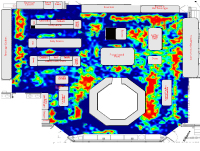ANALYTICS
SECTION ONE
SECTION TWO
In-Store Behavior Analytics for Optimizing Store Layout
By Rajeev Sharma
Analyzing shopper behavior gives retailers and manufacturers many critical insights. For example, by
following the shopper’s typical path through the store, trading partners can identify which displays
engage customers.
In the larger sense, in-store behavior analytics enables retailers to evaluate and optimize their store layout. One of the impediments to faster growth has been the cost of the data and analytics. Fortunately, the cost has dramatically dropped in the last couple of years due to new IoT (Internet of Things) sensors and cloud computing technologies. The use of the in-store infrastructure investment for other applications such as shopper marketing and category management is also making it easier for retailers to use in-store behavior analytics for optimizing store design.
VideoMining helped a major retailer on key investment decisions related to a “Center Store Reinvention” initiative, which involved breaking the long aisles into different destination departments. The performance of each department in the re-design was quantified and different alternatives for department adjacencies were evaluated.
Shopper behavior data provides an objective way to evaluate how successful the layout of current stores is. A range of analytics can be used to understand how the store layout is impacting the shopping behavior and experience, which in turn impacts the store sales performance. For example, heat maps of traffic and engagement provides an immediate understanding of the overall effectiveness of the store layout. Consistent “cold” areas in the store reflect a bad layout while a well spread out “red” indicates a good flow. Likewise, analytics of typical paths allows the retailers to refine the layout design to present the optimal sequences of departments to shoppers.
Retailers are especially interested in understanding shopping behavior around the perimeter of the store versus in the center store since it is tied closely to different trip types. Access to shopper behavior data for different trip types helps in evaluating the layout for each trip type. For example, while a particular store design may work well for stock-up trips, it may not be optimal for quick and fill-in trips. Since grocery stores are becoming more dependent on shorter trips, it’s more important than ever to evaluate layouts for these dominant trips.
In-store behavior analytics also enables retailers to identify issues related to congestion during peak shopping hours. They can use to data to identify “choke points” and then create layouts that minimize such bottlenecks. In fact, the behavior data can help in quantifying the potential lost sales if such crowding situations are not taken care of. Many of the new store layouts can be tested using multiple criteria where the shoppers in effect “vote” on the best design through their behavioral response.
It is critical for retailers to use in-store behavior analytics for optimizing layouts and the entire shopping experience. At a time when grocery e-commerce is growing, retailers would not want their physical stores to behind lag the shoppers’ online experience that has been optimized using web analytics.
Rajeev Sharma is Founder & CEO of VideoMining Corp., a State College, Pa.-based provider of in-store behavior analytics.
Click on the LinkedIn logo to join the new Shopper Technology Institute Discussion Group
SECTION THREE

